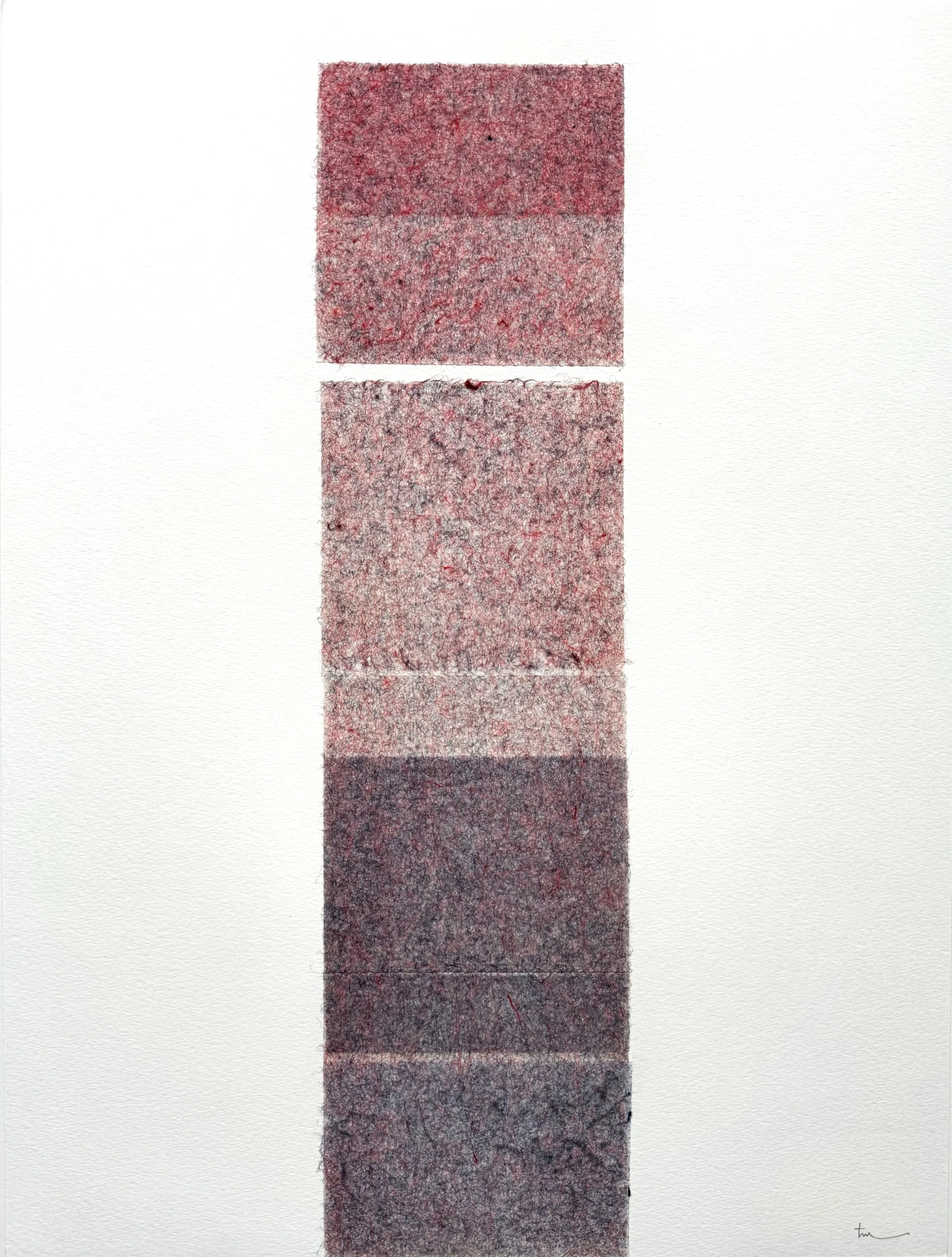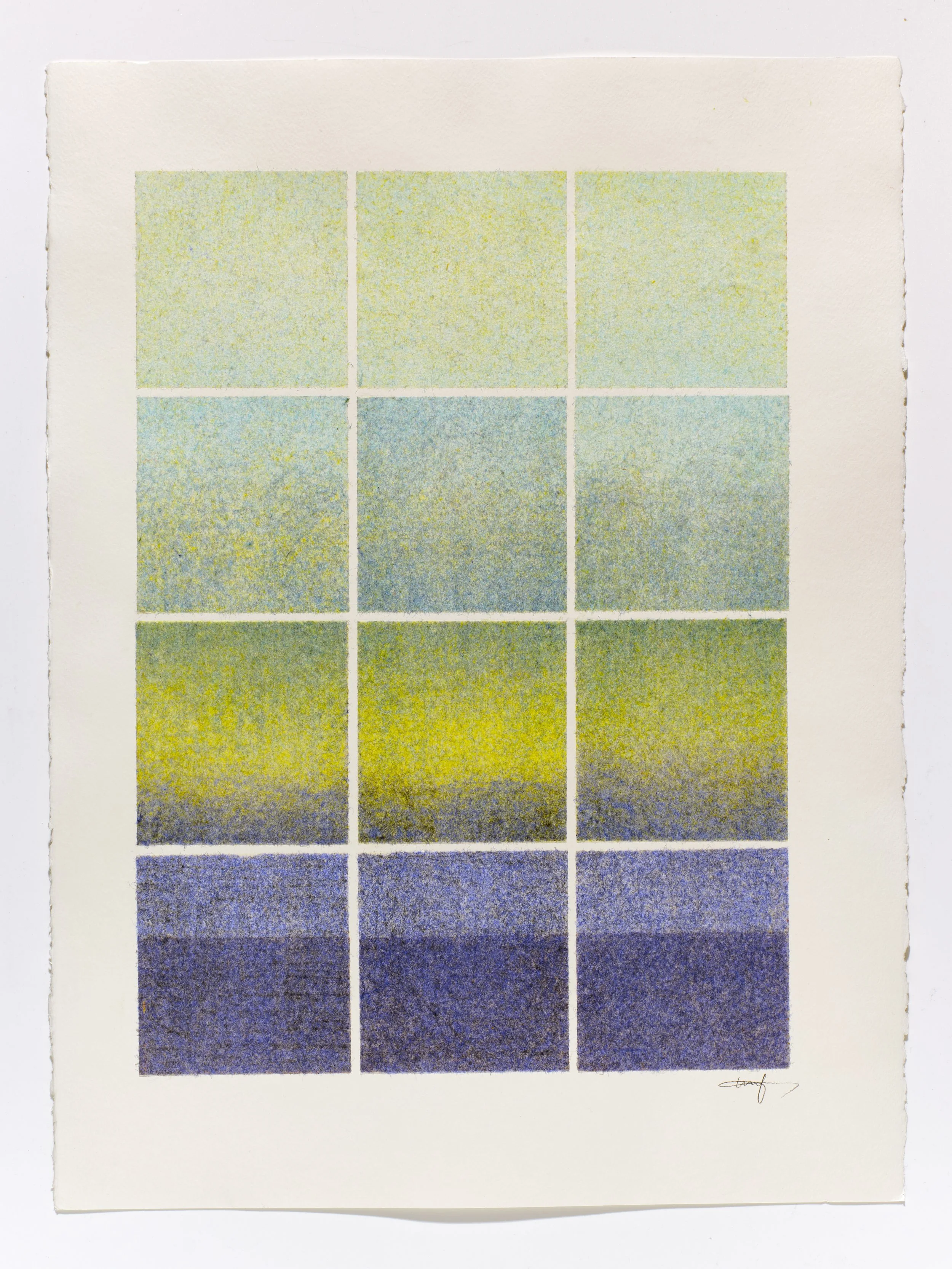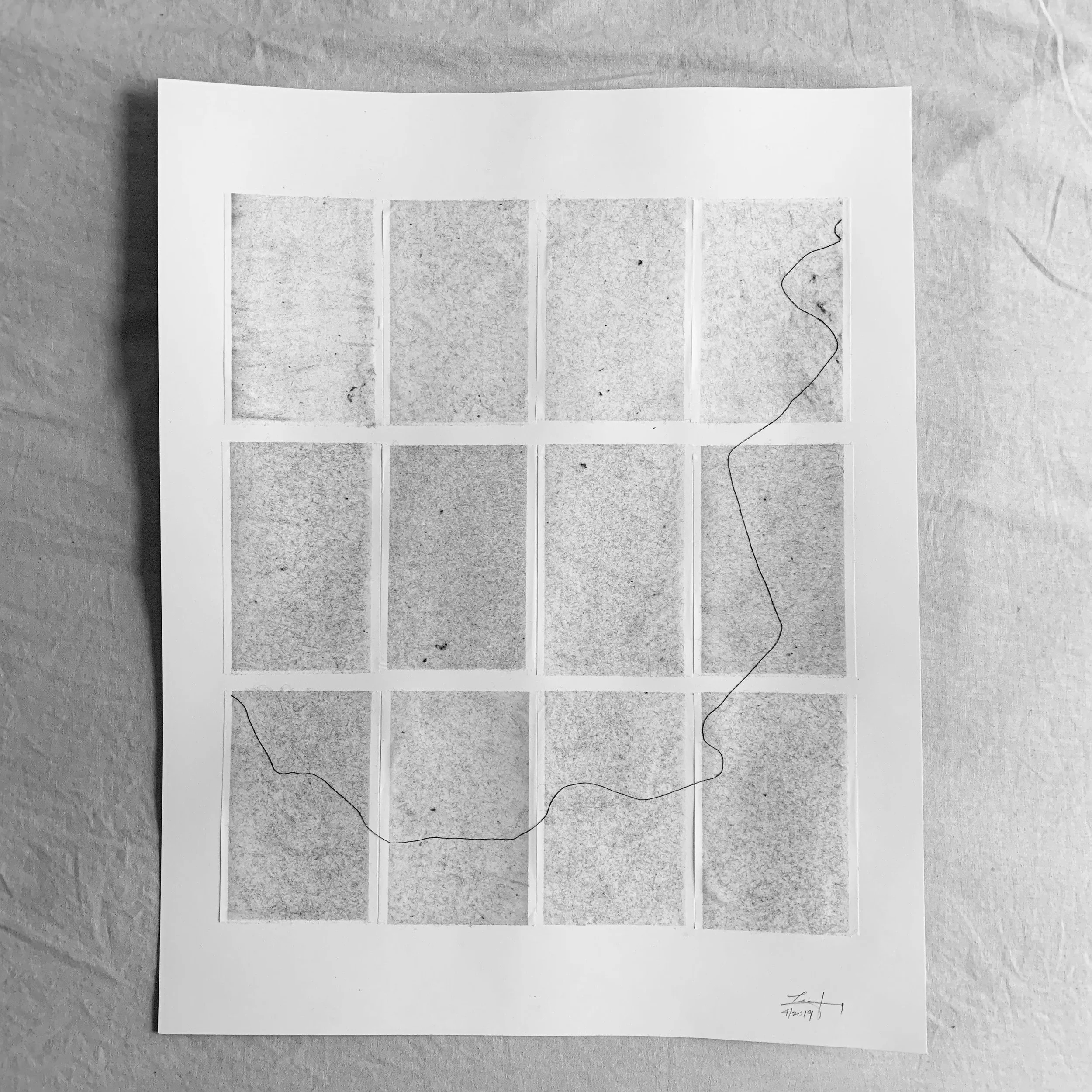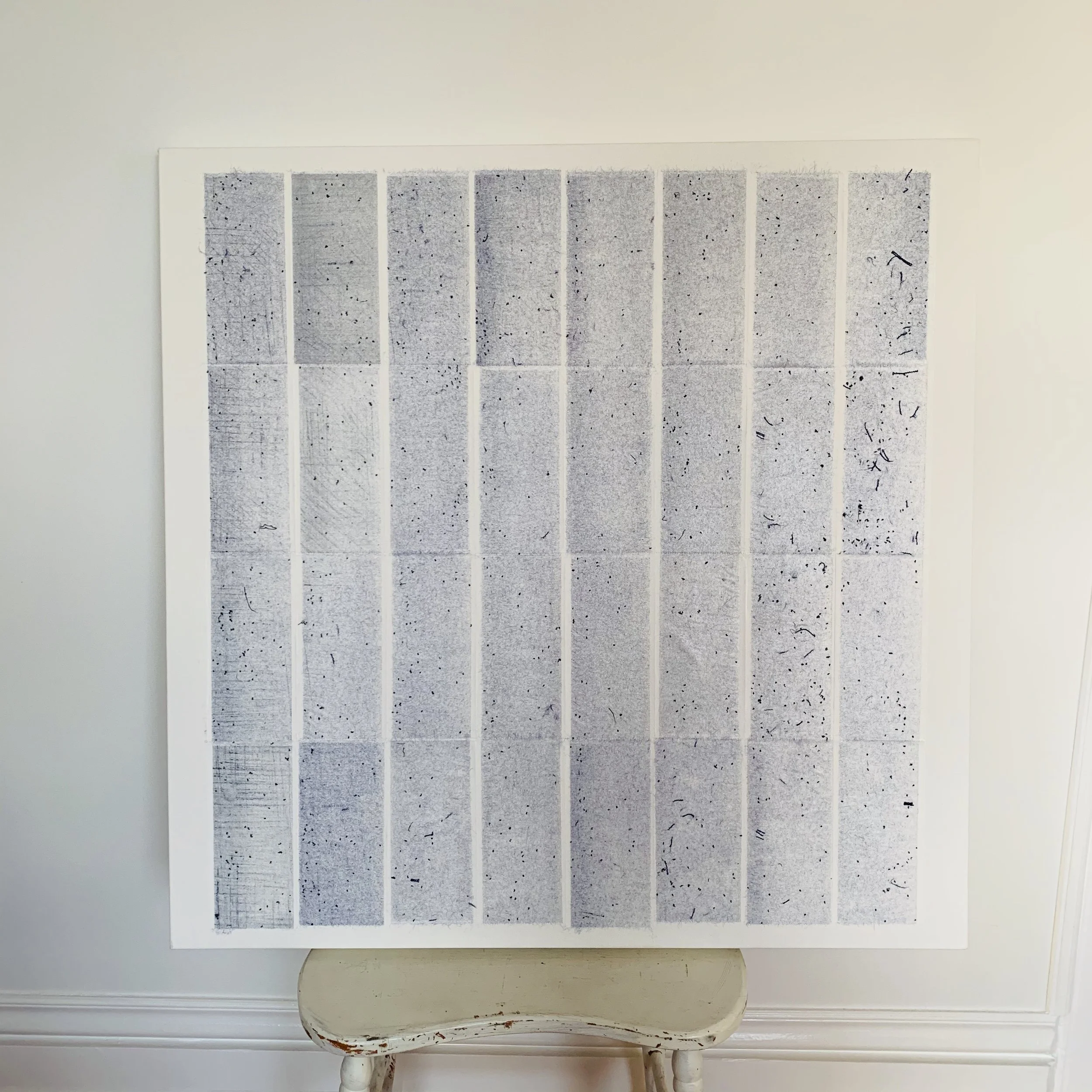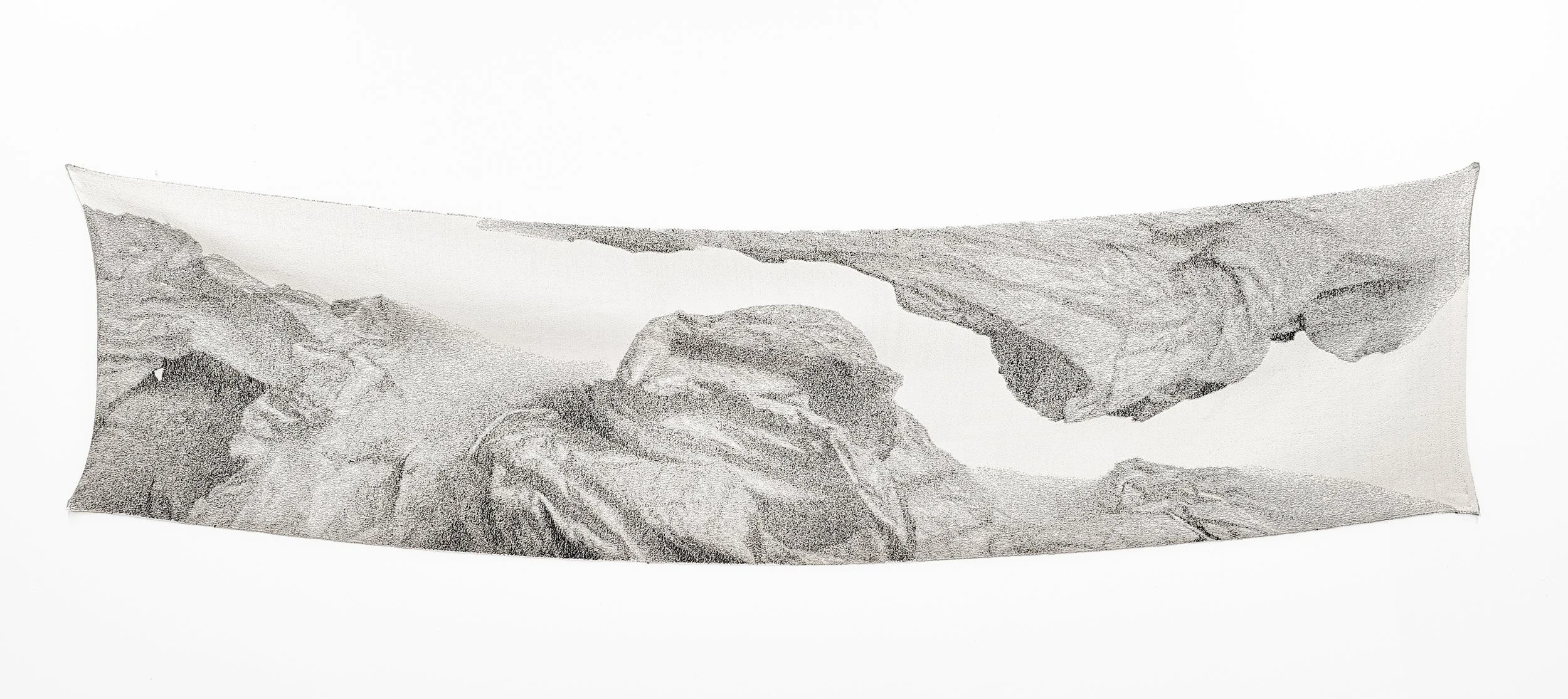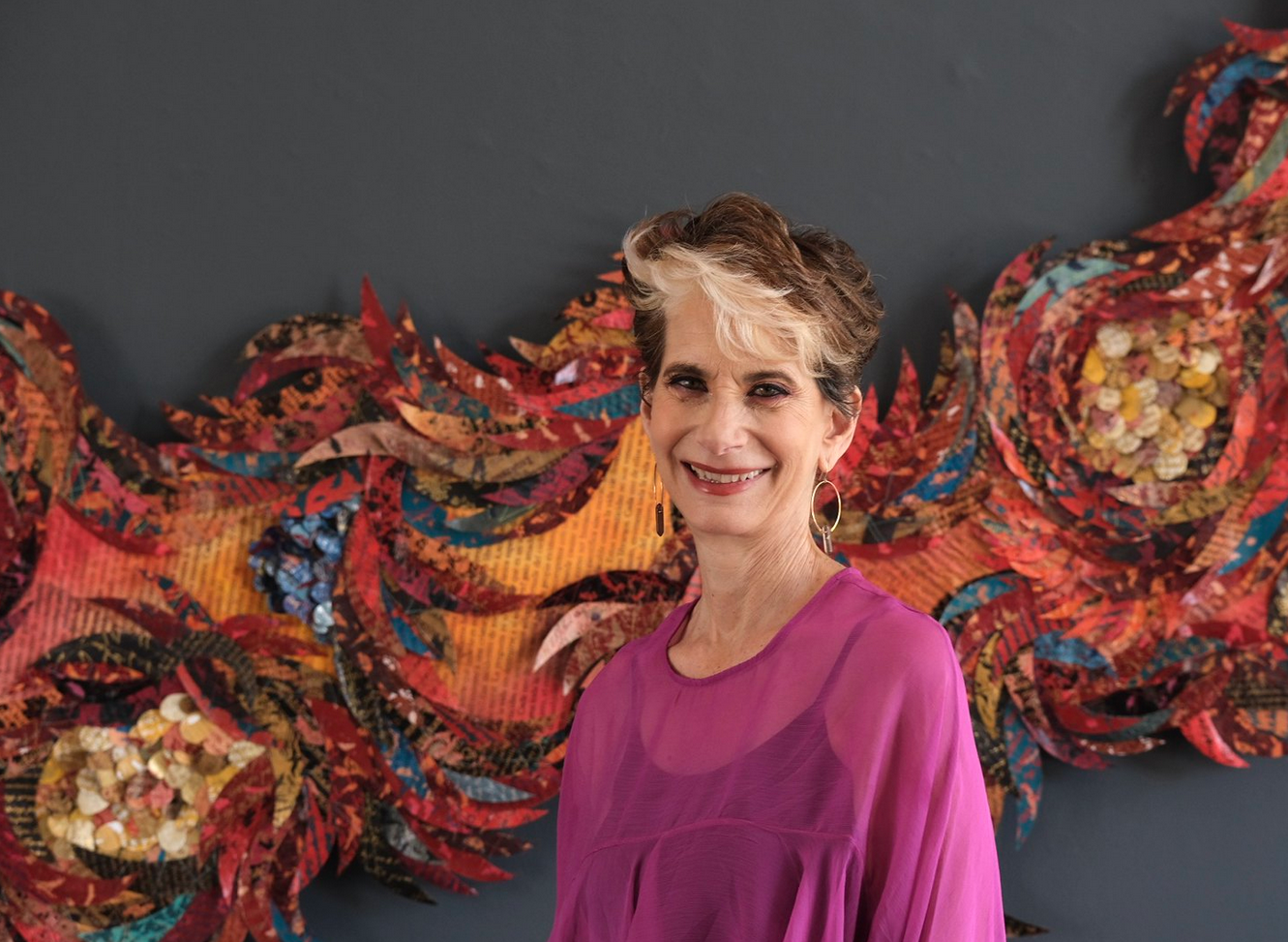10 Questions with Tinmin
Tinmin - Portrait
Tinmin is a contemporary abstract artist known for pioneering an innovative technique that uses a lint roller to extract and manipulate fibres from vintage garments and fibrous materials. He transforms these elements into vibrant, textured compositions on paper, breathing new purpose and life into them. His work is characterised by striking abstract imagery, rich in colour and depth, evoking a palpable sense of calm and movement.
He is the Director of Technical Development at Fogarty Finger Architecture PLLC. He has over 20 years of professional experience covering the design and construction of a broad range of building types, from single residences to high-rise buildings. He was also a co-founder of Kanso Homes, a real estate development platform that empowered moms and pops landowners to develop their untapped development potential to increase housing in urban infill lots in Seattle, WA, by guiding them through a transparent and seamless development process utilising factory-built homes.
Tinmin was born in Rangoon, Burma and educated in the United States of America. He graduated from the School of Architecture and Environmental Studies at the City College of New York in 2005.
ARTIST STATEMENT
As a mixed-media artist, Tinmin utilizes a lint roller to extract and manipulate fibers, transforming them into vibrant, textured compositions on paper. Through his work, he seeks to give new life to objects that were once loved, cherished, and have served their purpose. For example, he extracts fibers from vintage or discarded garments to create striking abstract imagery, rich in color, depth, and a palpable sense of calm and movement.
Tinmin’s artistic vision is fueled by a diverse range of inspirations, from intimate personal experiences and the natural world to profound philosophical concepts and contemporary social events. This breadth of influence translates into evocative works that encourage viewers to engage in personal reflection and interpretation.
His architectural background and deep appreciation for minimalist artists—including Donald Judd, Sol LeWitt, Agnes Martin, Mark Rothko, Ellsworth Kelly, and Josef Albers— have profoundly shaped his artistic methodology. Employing the lint roller as an unconventional tool, he transforms fibers into painterly compositions through a meticulous process of extraction, blending, and layering. This experimental approach challenges traditional abstract practices, resulting in work that elicits powerful emotional responses.
Based in New York, Tinmin remains committed to expanding the horizons of abstract expression. His ongoing exploration of new techniques, mediums, and conceptual frameworks fuels his visual storytelling, which is deeply rooted in memory, experience, and emotion. Ultimately, his art strives to establish a genuine and profound connection with the viewer.
Cube #01, Fibers on paper, 22”x30”, 2020 © Tinmin | Photo Credit: Samuel Bristow
Cube draws inspiration from a journey to Mafa, merging elements of the landscape and cultural experiences into a unique artistic expression.
INTERVIEW
Let’s start with your background. Can you tell us about your journey from architecture to contemporary art? How does your background shape your artistic practice?
My background in architecture continues to shape the way I approach contemporary art. The two fields share a common creative language—texture, colour, proportion, and the interplay of light and shadow—so the transition felt like a natural evolution. While architecture is often driven by commercial needs and client considerations, art offers a more personal journey with complete creative freedom. Architecture also taught me discipline and the value of refining ideas through repetition and iteration. That’s a process I still embrace—revisiting a gesture or material until it truly resonates. It’s become a fundamental part of how I work today.
2020 #03, Fibers on paper, 18”x24”, 2020 © Tinmin
You also maintain a professional role in architecture. How do you balance both careers, and do they ever intersect creatively?
In my professional architecture role, I’m sometimes called a “People Tree Grower”—a phrase that reflects my devotion to nurturing growth. I see mentoring as planting seeds of confidence and creativity, giving others the space and support to develop their own voice. There’s a quiet joy in watching people grow into their full potential, and that exchange of energy also nourishes my own art practice. Because I give so much creative freedom to my staff, art becomes my personal outlet—a space that’s entirely my own. My artwork runs alongside architecture—it’s more intuitive, experimental, and deeplypersonal. While the two disciplines don’t always overlap, they continue to inform one another. At their core, both are rooted in the same values: simplicity, movement, calm, balance, and joy.
Speaking of your work, what inspired you to use a lint roller as a primary tool, and how did that technique evolve over time?
Being in a creative profession, I’ve developed a strong appreciation for what’s visually compelling and aesthetically beautiful aspects found in the overlooked details of daily life. One day, while using a lint roller on my coat, I was struck by the unexpected beauty of the used adhesive sheet—the textures, the soft layers, the traces of everyday life it had picked up. It made me pause and think: how could I bring out this hidden beauty, give it a second life, and use it to tell a story? That moment of curiosity sparked an ongoing exploration, turning a simple household tool into a central part of my artistic journey.
Triple S (Sea, Sky and Sun) #01, Fibers on paper, 22” x 30”, 2025 © Tinmin | Photo Credit: Samuel Bristow
Marble #01 Indigo, Fibers on paper, 22” x 30”, 2025 © Tinmin | Photo Credit: Samuel Bristow
Triple S (Sea, Sky and Sun) #02, Fibers on paper, 22” x 30”, 2025 © Tinmin | Photo Credit: Samuel Bristow
Marble #02 Jade, Fibers on paper, 22” x 30”, 2025 © Tinmin | Photo Credit: Samuel Bristow
You often use fibres from vintage garments. What draws you to these materials, and how do you choose them?
Sustainability is something I care about deeply—both in my everyday life and in my creative work. I’m especially drawn to vintage garments and discarded materials because they’ve already lived a life. They were worn, loved, and carry traces of memory and history—and there’s something powerful in that. When I work with these fibres, I’m not just recycling; I’m giving them a second life, allowing them to become part of a new story. I approach material selection much like a director casting a film: each fibre, chosen for its colour, texture, and narrative resonance, plays a distinct role in shaping the story I want to tell through my work.
How do you begin a new piece? Can you walk us through your creative process from concept to completion?
My process always begins with a story—an idea, emotion, or moment I feel compelled to express. That narrative becomes the foundation for everything that follows. From there, I choose materials that echo the mood or message of the piece. I use a lint roller to extract and blend fibres, layering textures the way you might build a sentence—carefully, intuitively. Each sheet becomes part of the visual story, with colour, form, and composition working together to bring the narrative to life. In the end, it’s really about translating feeling into form—one fibrous layer at a time.
Triple S (Sea, Sky and Sun) #03, Fibers on paper, 22” x 30”, 2025 © Tinmin | Photo Credit: Samuel Bristow
The Triple S series is inspired by the vivid colors of the Sea, Sky, and Sunset, evoking moments of enlightenment from Tinmin’s journey. These lightscapes and scenes became a sanctuary, where he found peace through transformation - navigating the complexities of love lost and love discovered.
Many of your works evoke calm and movement. Are there specific memories or emotions you aim to convey through your compositions?
My artwork is a direct expression of how I’m feeling in the moment. I’m generally a calm person, but there’s always an undercurrent of movement—whether it’s a restless mind or a body in motion—and that quiet energy often finds its way into my compositions. I don’t usually begin with a specific memory or emotion; instead, feelings surface naturally, shaped by everyday experiences like travel, conversations, current events, or simply the surrounding environment. The calm or movement people sense in the work often reflects my emotional state while creating. Each piece becomes a visual record of that shifting inner landscape. The way I layer fibrous materials adds to the emotional depth—they catch light in subtle ways and respond to the viewer’s movement, creating a quiet sense of presence and flow.
Which artists or art movements have had the most impact on your work, and in what ways do they influence your style or philosophy?
I am drawn to minimalist architecture and design—work defined by refined proportion, colour, texture, and a sense of movement or unexpected detail. That philosophy guides both my architectural and artistic practices: to create work that is simple, intentional, and emotionally resonant for the viewer. Artists like Donald Judd, Dan Flavin, Sol LeWitt, Agnes Martin, Richard Serra, Damien Hirst, Anthony McCall, Yayoi Kusama, and many others have influenced me in different ways. Their ability to distil complex ideas into minimal forms—while still evoking strong sensory or emotional responses—has shaped how I think about space, repetition, material, and experience. My style is rooted in simplicity and minimalism, but never static. I aim to evoke quiet movement and a sense of joy in everything I create.
Seashore #01, Fibers on paper, 18”x24”, 2019 © Tinmin
Fluted column, Fibers on Canvas, 36”x36”, 2019 © Tinmin
Your work often touches on memory, experience, and emotion. Do you see your art as a form of personal storytelling?
Absolutely. A lot of my work comes from personal memories and emotions—it’s how I make sense of what I’m feeling. Even though it starts with my own story, I hope it creates space for others to connect in their own way and find something that resonates with them in the work.
How has your art been received by audiences and the art community? Have any responses or interpretations surprised you?
For me, making art is a meditative process—it’s how I release creative energy and turn it into something tangible. What’s been really encouraging is that people often tell me they feel a sense of calm, peace, or even joy when they see the work, even without knowing the story behind it. That’s been a bit surprising, honestly, because it all comes from such a personal place. But hearing that it resonates with others has been really meaningful. I’ve only recently started sharing my work more publicly, and this is actually the first time I’m talking about it in a magazine, which is exciting.
Lastly, what can we expect from you next? Are there any new techniques, collaborations, or projects you’re excited about in 2025?
Right now, I’m working on a new series called Meadows, which I’m really excited about. What’s interesting is that it’s starting to feel a bit like classic artwork, just reimagined through a completely different medium. I’m also planning to experiment with a custom-made large lint roller. It’s definitely unconventional, but I think it could open up some exciting possibilities for working on a larger scale.
Artist’s Talk
Al-Tiba9 Interviews is a promotional platform for artists to articulate their vision and engage them with our diverse readership through a published art dialogue. The artists are interviewed by Mohamed Benhadj, the founder & curator of Al-Tiba9, to highlight their artistic careers and introduce them to the international contemporary art scene across our vast network of museums, galleries, art professionals, art dealers, collectors, and art lovers across the globe.



